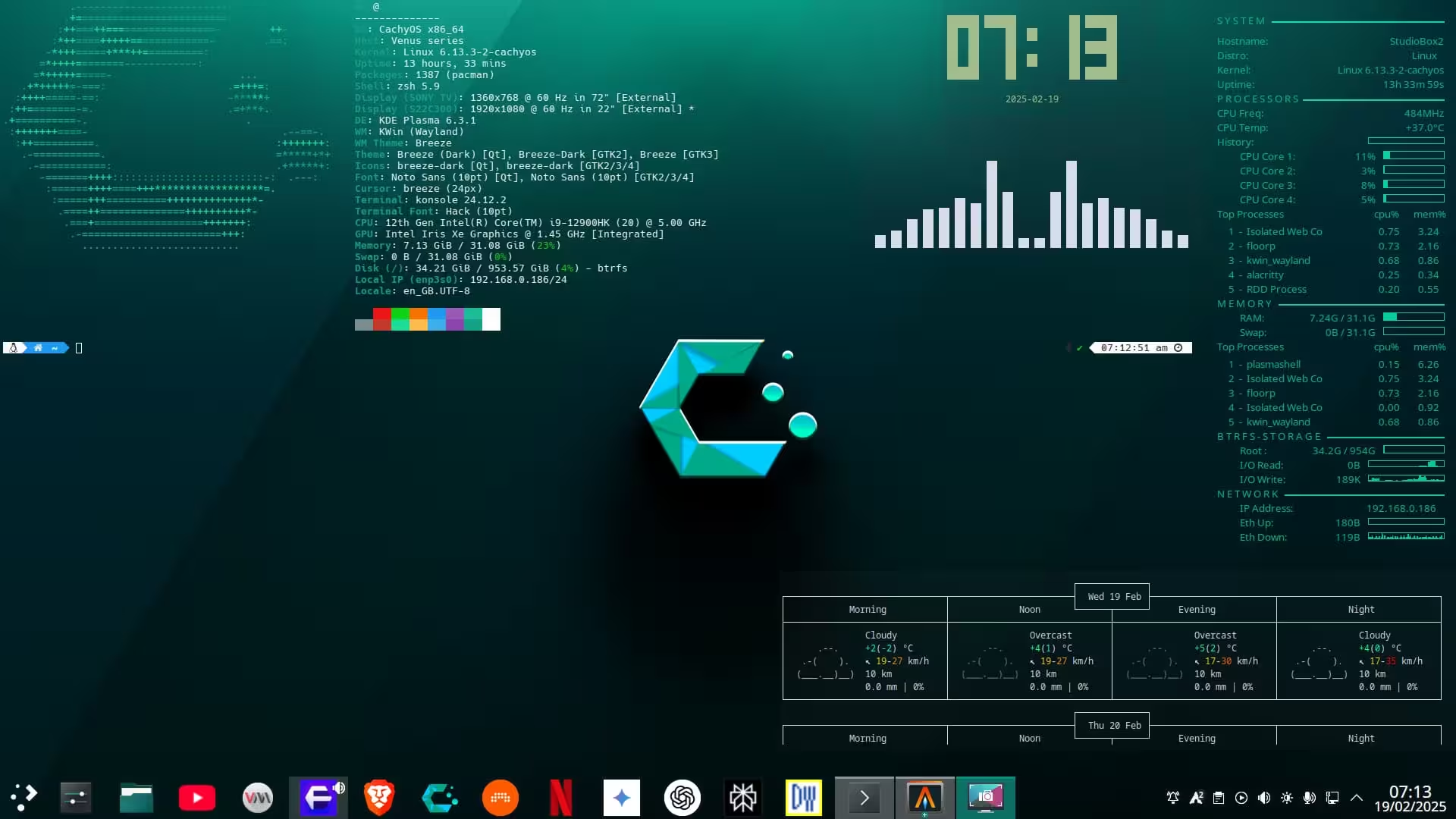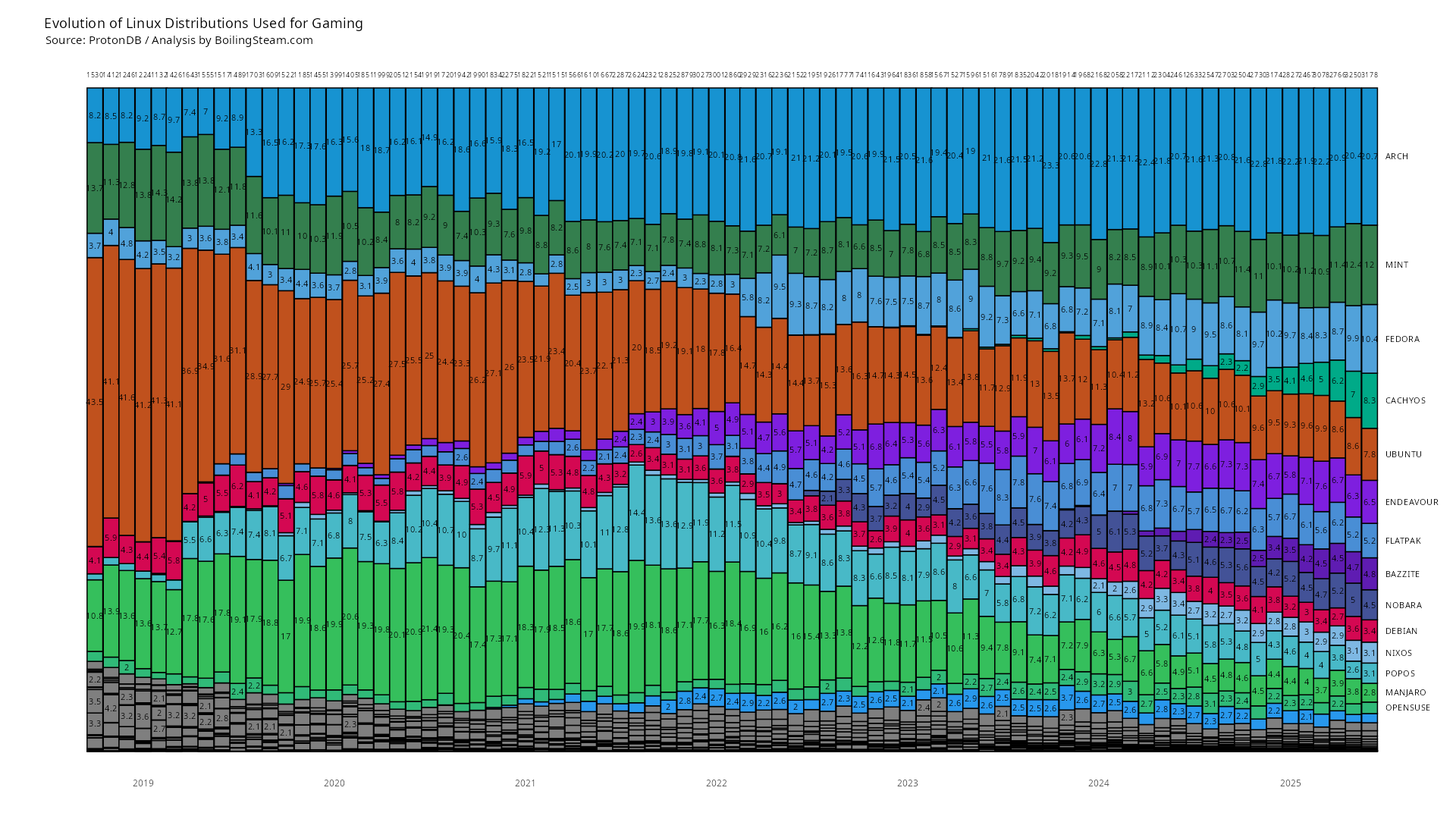Linux Distros for Gaming: CachyOS Takes Over
It’s summer. Usually everything is pretty quiet. There’s no reason to make waves unless you are on the beach. Just out of curiosity, I was checking a few days ago what happens to the Linux distros used for gaming, expecting no change at all from a few months ago. Boy, I was wrong. I told you last time that CachyOS was the fastest growing distro back in May 2025. You would expect such statements to tamper down over time: you can’t usually grow forever on a very competitive market. Well… until now.
First before the results, the usual disclaimer, as this data comes from ProtonDB:
- This may not be representative of all types of Linux users. I’m sure this is not what your AWS engineer uses on EC2.
- This may not be completely representative of all Linux gamers either. But I’d wage this is actually a good predictor where the market is going to shift. We saw first that Manjaro was getting the boot here first, before going under pretty much everywhere.
- There may be some additional biases, due to whoever used ProtonDB.
- Flatpak is NOT a distro, but that’s what Steam reports when it’s running on Flatpak, and Flatpak being distro independent we report it as a separate environment, if that makes sense. Feel free to ignore it if you wish.
- Arch Linux is Arch Linux on desktop. The Steam Deck’s OS is reported as HoloISO, not Arch Linux, so stop trying to claim that Arch is first because of the Steam Deck! This is mainly data reported from desktop PCs, so no, SteamOS is not a thing at the moment on such machines. This may change as Valve starts providing official support beyond the Steam Deck.
Now on to the results. You might want to click on the picture to enlarge it.
Now let’s review the changes in more details.
CachyOS overtakes Ubuntu
It seems almost unreal. Ubuntu is now becoming a minority choice for gamers on Linux. Back in 2019, it was almost the default with more than 40% of gamers using Ubuntu. Now, look how far things have gone: Ubuntu is at less than 8% usage share! And CachyOS, continuing on its steady growth, has overtaken Ubuntu as it reached 8.3% based on the last figures. Even you were to discount CachyOS, Ubuntu would be on the third spot for several months now after Fedora anyway. Canonical is clearly losing steam, and very fast, at least for those who care about games.

Note that CachyOS is not just a popular topic for gamers, it turns out that it’s reached the top spot on the DistroWatch ranking too, by far. So it’s getting noticed. If you are interested to know more about their features and options for customization, you can also check their wiki. There are also recent comparisons of the performance of Bazzite, SteamOS and CachyOS on the Steam Deck, such as in this video (get ready for some rough French accent!) and while CachyOS performs well overall, it does not seem to bring any advantage compared to SteamOS in terms of FPS in games. At least for this device.
Back to the top of the ranking, Fedora seems to solidify around 10% more or less, and Mint is just a step beyond that with typically about 12%, making it stay at a solid 2nd place as well behind Arch that remains the undefeated master for many years now. As CachyOS grows, it may start to cannibalize some of the share of Arch Linux, but so far it looks like its growth has been mostly out of non-Arch Linux users.
Losing Big: Pop!_OS and Manjaro
Manjaro is landing into the depths of the ranking, now below 3% - it won’t be too long until its name is removed from the list. Nothing surprising if you have been following the drama around the distro, and the fact that it completely lacks a reason for existing in 2025 compared to what’s already out there.
Pop!_OS also barely makes it above 3% - no wonder since it’s not been updated for years, and the System76 team seems to be more focused on COSMIC than anything else these days. Too bad, because at its height, Pop!_OS was a great Ubuntu alternative, with a lot of useful features baked in and a very stable experience. It could have been the new Mint it they had managed to keep resources allocated to work on it. Now, it’s not clear that they would be able to claw back some share even if they magically released a new version tomorrow: I’d say the trust is gone after so little activity for such a long time. In a way, Mint is the excellent counter example. It does not make waves, barely anyone talks about it, but sticks to a high quality distro release schedule, and the results speak for themselves: stability and trust is paramount.
Holding up: Bazzite, Nobara and NixOS
Despite the changes around them, both Nobara and Bazzite seem to keep hanging on at a stable share, close to 5% each. However it seems that both have stopped growing at that point and may be stuck at the current threshold. I’m not sure there is however much future when it comes to Bazzite, since SteamOS will eventually be rolling out to more and more devices out there. I guess it depends how much Valve does in terms of hardware support, and if Bazzite provide tangible benefits on top what Valve delivers.
As for NixOS, it’s smaller in share at around 3%, but seems to be doing well. It’s not an household name you hear a lot when gaming is the topic on Linux, but the fact that there’s a solid base that does not go away seems to indicate it’s providing a solid experience in that field.
What to expect next?
Eventually CachyOS will find its own (stable) position on the market. I don’t think it will become number 1 anytime soon. It may be going up to 10%, and who knows, challenging Mint at some point in terms of share. It’s hard to predict as there has not been such a dramatic rise in any new distro up until now. Ubuntu will probably continue to lose share, there’s no coming back at this stage when every other option just looks better, and Ubuntu has pretty much moved its focus away from the consumer market to find something more profitable. The 24.04 LTS release was the last chance to get some traction, but it eventually failed to gain any market among gamers.
In any case, be ready to be surprised. Already 2025 looks nothing like 2024, so who knows what’s cooking for 2026!

